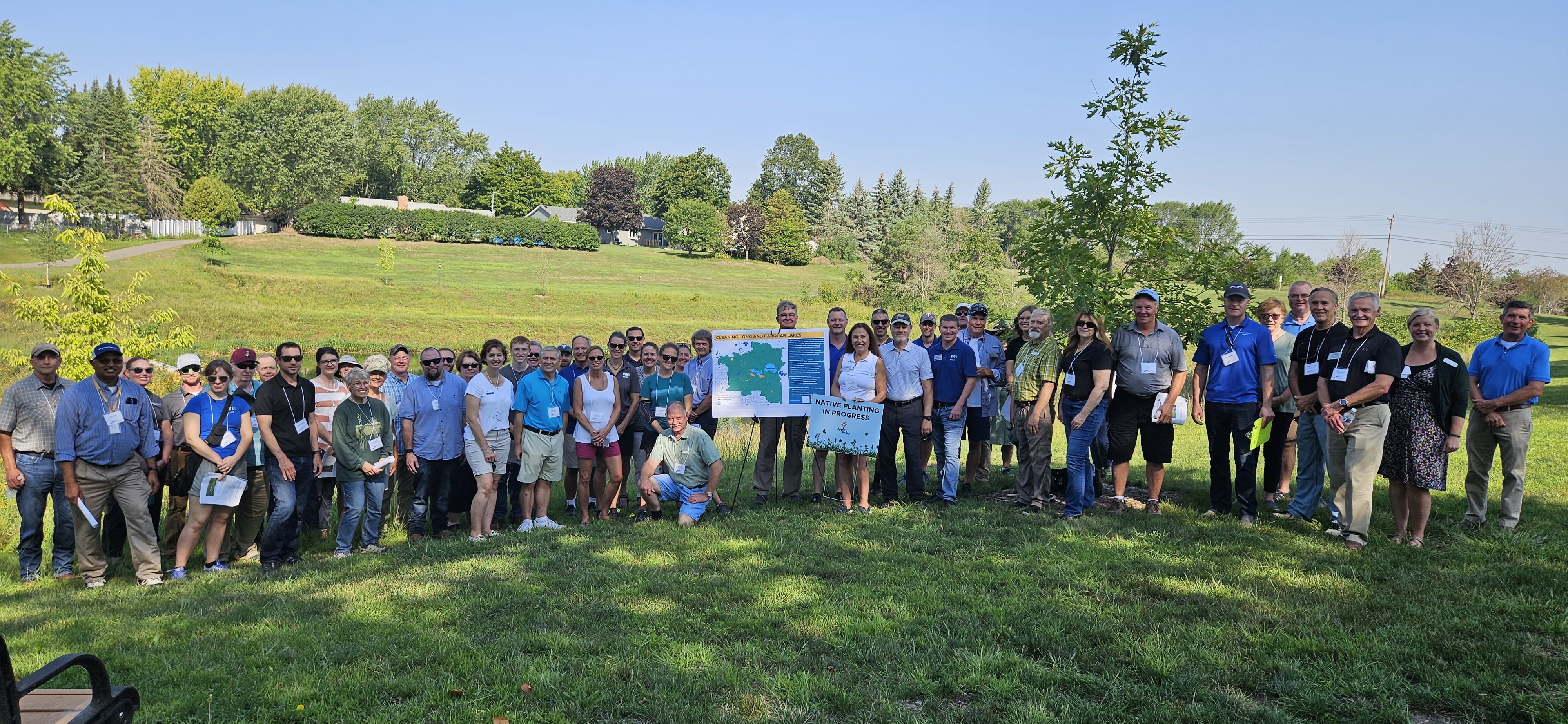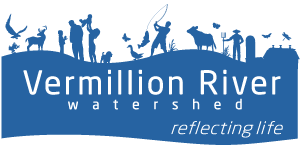
Projects and Practices Improving and Protecting Water Resources are Focus of Watershed Tour
More than 60 people collaborating on urban and rural conservation projects and practices attended a tour with the Minnesota Board of Water and Soil Resources (BWSR) and partners within the Vermillion River Watershed on Wednesday, Aug. 23, 2023. BWSR selected the Vermillion River Watershed for their annual Board tour this year. Attendees included representatives from:
- elected officials and staff of the cities of Lakeville, Farmington, and Apple Valley
- landowners
- BWSR board members and staff
- Dakota County Soil and Water Conservation District
- University of Minnesota Extension
- Minnesota Legislative Subcommittee on Water Policy
- state agencies including the Minnesota Pollution Control Agency, Department of Agriculture, and Department of Natural Resources
- federal agencies including the Farm Service Agency, Natural Resources Conservation Service, and U.S. Fish and Wildlife Service
- conservation advocacy groups, including Minnesota Watersheds, Minnesota Association of Soil and Water Conservation Districts, and The Nature Conservancy
- Dakota County Commissioners and staff
- the Vermillion River Watershed Joint Powers Organization (VRWJPO) board, planning commission, and staff
The group toured eight locations:
Lakeville
- Habitat Restoration at East Lake
East Lake has historically exhibited degraded water quality, leading to the lake’s designation as impaired due to excess nutrients. In addition, the woodlands adjoining East Lake host a prolific invasive species population within the woodland understory. In 2021, the City of Lakeville completed a habitat assessment that identified the need to continue restoration efforts within and surrounding the lake and were subsequently awarded a Conservation Partners Legacy (CPL) grant to restore 1,600 feet of shoreline and enhance 18 acres of the native oak savannah. As less than 1% of Minnesota’s native oak savanna remains, the project provides unique critical habitat by preserving a disappearing ecosystem and helps improve water quality in East Lake.
Project partners included the City of Lakeville, VRWJPO, and Minnesota Department of Natural Resources.
- Stormwater Reuse System at King Park
The City of Lakeville proved stormwater runoff can be a reusable asset. A three-phase irrigation system plan was implemented to prevent stormwater runoff from filling ponds and overflowing into Middle Creek, reducing bank and channel erosion. Phase one: The first pump system was installed in 2011 to irrigate two baseball fields and draw down the pond level. Phase two: A second, larger pond was built to capture stormwater runoff from the newly reconstructed portion of Dodd Boulevard in 2016. The large pond made it possible to install a new, larger pump station that would irrigate two additional baseball fields. Phase three: In 2019, the remaining four baseball fields and some common areas in the park were irrigated using pond water. Since the beginning of the project, staff enhanced the efficiency and operation of the irrigation system.
Middle Creek is an impaired tributary to the Vermillion River. Its water quality problems can be improved by reducing the amount of excess stormwater runoff. Using stormwater rather than groundwater from the municipal water supply to irrigate conserves Lakeville’s drinking water and demonstrates smart water use, while preventing excess stormwater from reaching Middle Creek.
The reuse system has reduced groundwater use by several million gallons per year, though it’s varied during wet and dry years. Other benefits include reductions in total suspended solids pollution, total phosphorus, E. coli bacteria, and excess stormwater discharged to Middle Creek.
Project partners included the City of Lakeville, VRWJPO, BWSR, and Dakota County.
Apple Valley
- Stormwater Improvement Project in Erickson Park
Erickson Park provides open space and flood retention for the surrounding residential areas. When the stormwater pond and piping were installed in the area 45 years ago, the focus was on holding water after heavy rains, not on addressing water quality. As a result, the runoff from most storms passed through the pond with very little pollutant removal. Stormwater flows through Erickson Park and ultimately reaches Farquar Lake, which is impaired for nutrients (phosphorus).
In 2021, the City of Apple Valley and VRWJPO, with support from a Watershed-Based Implementation Funding grant from the Minnesota Board of Water and Soil Resources (BWSR), retrofitted the pond to provide additional water quality treatment and infiltration. The Erickson Park stormwater improvements will provide better management and treatment of low flows, reduce phosphorus delivery to Farquar Lake, and provide better access for maintenance and sediment removal in the long-term. Phosphorus reduction at Farquar Lake resulting from the project is estimated at seven pounds per year. Partners avoided construction in the existing pollinator garden in the northern portion of Erickson Park, allowing two environmentally sustainable projects to work alongside each other and educate community members.
The City of Apple Valley, VRWJPO, and BWSR partnered to complete this project.
Farmington
- Stream Restoration in Rambling River Park
Rambling River Park is a popular recreation destination offering many amenities including a trophy trout stream with a self-sustaining brown trout population. The segment of the Vermillion River running through Rambling River Park has been impaired for turbidity, insufficient dissolved oxygen, and aquatic life. These problems arose from insufficient in-stream habitat, streambank erosion and excess sediment from upstream sources, inadequate connection to the floodplain, and lack of native riparian vegetation.
This project, completed in 2017, included:
- Constructing bioengineering practices on the banks and channel of the Vermillion River, including cedar tree revetments, rootwad installations, and encapsulation soil lifts with integrated woody material
- Excavating soil to better connect the Vermillion River to its floodplain
- Controlling site access to sensitive areas with the intent of minimizing wetland impacts
- Excavation that minimizes damage to existing site conditions
- Native seeding and plantings
- Reconstructing the existing bituminous trail in the project work area and extension of a spur trail to provide fishing access
Project benefits include improved habitat quality, quantity, and diversity; a narrower channel that makes sediment movement easier, cooler temperatures, improved dissolved oxygen concentrations, and enhanced fishing conditions.
Partners included the City of Farmington, Southern Dakota Sportsmen’s Club, Dakota County Soil and Water Conservation District, VRWJPO, and Minnesota Department of Natural Resources.
Castle Rock Township
- Nitrate Treatment Wetland near the South Branch of the Vermillion River, Castle Rock Township
Nitrate is generally associated with non-point source runoff and can cause health issues for humans and animals. The South Branch Vermillion River subwatershed has the highest nitrate load in the watershed. It contributes to contaminated groundwater (drinking water) in the eastern portion of the watershed due to the area geology that allows for river water to leak into the underlying drinking water aquifers.
Dakota County reconstructed County Road 78 in 2017, which allowed the VRWJPO to design and construct a nitrate treatment practice adjacent to the road and concurrent with the road project to save on construction costs. A constructed wetland was created and enhanced with woodchips. The woodchips provide an additional carbon source in the wetland soil. This allows nitrate-reducing bacteria to thrive within the wetland, leading to more nitrate reduction than a wetland alone. A pre-treatment pond settles the bulk of sediment prior to discharging into the wetland.
The South Branch Vermillion River has averaged 200,000 pounds of nitrate per year as measured at the VRWJPO’s subwatershed outlet monitoring station. The project is estimated to reduce total nitrate by 13,600 lbs. per year and total suspended solids by 7.6 tons per year. Additionally, the wetland improves habitat conditions in the South Branch Vermillion River and Vermillion River mainstem, where sediment is often responsible for covering or filling critical wildlife refuge and spawning areas. This is important for the trophy brown trout population.
Project partners included the VRWJPO, Dakota County, and BWSR.
Vermillion Township
- Groundwater Protection Strategies on the Chuck Louis Farm, Vermillion Township
Most drinking water in Dakota County comes from groundwater, and many of the soils types found in the region are vulnerable to groundwater contamination. The Agricultural Chemical Reduction Effort (ACRE) is an outcome of the 2020-2030 Dakota County Groundwater Plan, which identified farm chemicals – nitrate, crop herbicides, and chloride – as risks to drinking water in rural parts of Dakota County. Through ACRE and the Minnesota Department of Agriculture’s Nitrate Fertilizer Management Plan (NFMP), the local agricultural community is involved in problem solving to address concerns about unsafe levels of contaminants, with focus on reducing nitrates in groundwater. Both ACRE and the NFMP will use voluntary actions to reduce chemicals in groundwater. Dakota County Soil & Water Conservation District staff provide technical assistance to farmers like Chuck Louis to help them meet goals for conservation, with support from the Dakota County Groundwater Protection Unit and Minnesota Department of Agriculture.
Dakota County is the second largest irrigated county in the state of Minnesota with an estimated 60,000 acres of irrigated land on 200,000 acres of farmland. Landowner Chuck Louis described technology and online tools to reduce the demand on groundwater and manage water in the root zone, helping reduce nutrient loss.
Hampton Township
- Braun Wetland Bank Easement
Wetland banks offset wetland impacts that occur from development, road projects, or other land uses in another location. The Braun wetland bank easement includes 120 acres and was restored by severing over 17 miles of subsurface drain tile, removing a lift station that pumped groundwater to a tributary stream, plugging surface water ditches, and reseeding with native wetland species. The site had been used for sod or agricultural crops since the 1970s. The restored wetland will provide flood retention, carbon sequestration, nitrate reduction, and wildlife habitat benefits.
Both the Dakota County Board of Commissioners and the Vermillion River Watershed Joint Powers Board adopted a policy that encourages the replacement of wetlands locally. BWSR has the responsibility of providing wetland mitigation for certain qualifying road repair and reconstruction projects conducted by local road authorities. The project will provide wetland credits to BWSR to assist with their statutory responsibilities and to Dakota County for mitigating capital improvement projects that are unable to avoid wetland impacts. The VRWJPO also partnered on this wetland bank to provide a local replacement option for private development ventures. This encourages wetland replacement in the same local watershed where wetlands are being lost. With the proceeds from selling wetland credits, the VRWJPO has created a revolving fund for establishing future wetland restoration projects.
Wetland bank partners included the Braun Family, BWSR, Dakota County, VRWJPO, and Dakota County SWCD.
Castle Rock Township
- Prairie Strips and Climate Resiliency Efforts with landowner Kurt Kimber
Siblings Kurt Kimber, Chris Kimber, and Carol Lowry grow food for local consumption including KernzaTM, small grains, food-grade soybeans, and sweet corn. Their 240-acre family farm uses contour farming and native prairie strips to intercept, filter, and infiltrate surface water runoff, with the goal of reducing erosion, treating all the water runoff before it leaves the field, and providing pollinator habitat.
The Kimbers’ practices improve their operation’s resilience against extreme climate events, reduced emissions, and help build soil organic matter which is important for carbon storage. In addition to their native prairie strips and KernzaTM crop, they have experimented with agroforestry by planting chestnut trees to aid in soil building and water retention. The Kimbers also plant cover crops and reduce tillage to promote soil health and farm resiliency. The farm became certified in the Minnesota Agricultural Water Quality Certification Program in 2017. The Kimbers continue to network with area growers, processors, and researchers to expand our local food web and associated supply chain.
Partners included: the Kimber Family, Dakota County SWCD, Dakota County, USDA – NRCS, Xerces Society, Minnesota Department of Agriculture, U of M – Forever Green, and Clean River Partners.
See a map and more detailed descriptions in the tour book.
While these projects and practices improve the Vermillion River and its tributaries, we can all do our part to protect water resources too. See the Vermillion River Watershed website for ideas, including Minnesota Water Stewards, Landscaping for Clean Water, and Adopt a Drain.


